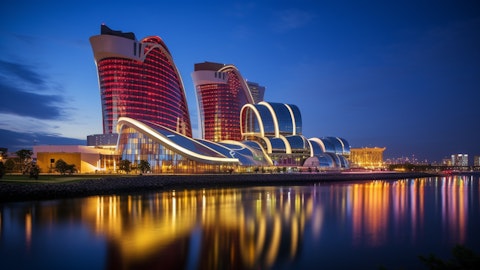We recently published a list of 7 Best ASX Stocks To Invest In Right Now. In this article, we are going to take a look at where Rio Tinto (NYSE:RIO) stands against other ASX stocks to invest in right now.
Overview of the Australian Economy
According to a report by the Australian Bureau of Statistics, Australia’s economy is growing at a sluggish pace as GDP for the June quarter increased by just 0.2%, bringing the annual growth rate to 1% for the year to June however, Australia continues to narrowly avoid a recession. According to Katherine Keenan, head of national accounts at the Australian Bureau of Statistics, the annual financial year economic growth was the lowest since 1991-92 excluding the Covid-19 pandemic period.
For the year to July, the Consumer Price Index (CPI) fell to 3.5%, from 3.8% in June which signals that inflation may be starting to ease. This reduction was largely attributed to energy rebates introduced by state and federal governments. In response, three of Australia’s big four banks have slashed interest rates on term deposits by as much as 80 basis points, signaling expectations of a significant rate cut in 2025. However, experts warn that inflation for the year to June remains “stubbornly high.” The Reserve Bank of Australia (RBA) has an inflation target of 2%-3%, and economists predict that rate cuts will likely not occur before 2025 due to inflationary pressures. Jim Chalmers, Treasurer of Australia acknowledged the economic stagnation and attributed the slow growth to a combination of global economic uncertainty, and the burden of higher interest rates.
Despite the economic challenges, wages in Australia continue to rise steadily, with a 4.1% increase for the year to June, slightly lower than the 4.2% growth recorded at the end of 2023. Private sector wages grew by 0.7% during the June quarter, down from 0.9% in the March quarter, while public sector wages saw a 0.9% increase, up from 0.6%.
Australian Equities Amid Inflation and Rising Rates
According to Schroders’ head of Australian equity, Martin Conlon, Investor sentiment toward investing in Australia reflects a cautious yet strategically optimistic approach, over the past decade, Australian equities, particularly in technology, growth, and green energy sectors, have enjoyed significant growth driven by speculative investment and aggressive financial leverage due to low borrowing costs. However, with the recent return of inflation and the necessity of higher interest rates, this sentiment has tempered.
However, real economy sectors such as resources, energy, and materials have gained traction due to more favorable investment opportunities. The mining sector, which represents a significant portion of Australia’s economic output, remains particularly attractive. Australia’s iron ore exports have long been a cornerstone of the economy, and global demand remains robust. Some of the largest mining companies in Australia maintain competitive advantages due to their low-cost operations, especially in iron ore production, which continues to generate strong cash flows even as global commodity demand fluctuates. Furthermore, Australia’s reserves of critical minerals like lithium and rare earths, essential for renewable energy technologies, position the country at the forefront of this transformation.
Investors are now prioritizing sectors with reasonable valuation levels and sound fundamentals, particularly those with exposure to the real economy. Resource stocks stand to benefit from global deglobalization trends as Western economies reduce their reliance on Chinese manufacturing. This shift is expected to result in higher costs for goods, further supporting the case for investing in resource-heavy sectors.
Despite the economic slowdown and inflationary pressures, the country continues to narrowly avoid recession. However, Australia’s unique position as a major commodities exporter and its exposure to the energy transition present compelling opportunities.
Our Methodology
For this article, we used the Finviz and Yahoo Finance stock screeners plus online rankings to compile an initial list of the 20 largest companies in Australia by market cap. From that list, we narrowed our choices to the 7 stocks with the most hedge fund holders, as of Q2 of 2024. The list is sorted in ascending order of the number of hedge funds.
Why do we care about what hedge funds do? The reason is simple: our research has shown that we can outperform the market by imitating the top stock picks of the best hedge funds. Our quarterly newsletter’s strategy selects 14 small-cap and large-cap stocks every quarter and has returned 275% since May 2014, beating its benchmark by 150 percentage points (see more details here).

Aerial view of an open pit mine, with workers extracting minerals.
Rio Tinto (NYSE:RIO)
Number of Hedge Fund Investors in Q2 2024: 29
Rio Tinto (NYSE:RIO) is a global mining company that operates in over 35 countries and specializes in extracting and producing a wide range of minerals and metals including iron ore, copper, aluminum, and other materials that are crucial for the global energy transition.
Iron ore was the primary revenue generator for Rio Tinto, however, the company is diversifying its operations into aluminum and copper which accounted for 37% of revenue in the first half of 2024. Forbes predicts that aluminum demand will surge by 50% by 2050, driven by the growth of electric vehicles (EVs) and renewable energy infrastructure. Copper demand is expected to grow by 75% over the same period. The World Bank forecasts modest price increases of 2% for aluminum and 4% for copper by 2025.
Rio Tinto’s (NYSE:RIO) key projects including the Resolution project in Arizona have the potential to produce 40 billion pounds of copper over the next 40 years. Other projects such as the Oyu Tolgoi underground copper mine in Mongolia, the La Granja copper project in Peru, and the AP60 aluminum smelter expansion in Canada, are expected to enhance the production capacity of its aluminum and copper products and position the company to benefit from increasing demand.
Rio Tinto’s (NYSE:RIO) stock is currently trading at 8.59 times earnings, the stock is at a 46% discount compared to the sector median of 15.86. In the second quarter, 29 hedge funds held positions in Rio Tinto (NYSE:RIO), with a total value of $1.29 billion. Fisher Asset Management is the largest shareholder, with a stake worth $1.12 billion as of June 30. Industry analysts maintain a consensus Buy rating for the stock, with an average price target of $81.88, indicating a potential upside of 25.64% from its current level.
Overall RIO ranks 1st on our list of best ASX stocks to invest in right now. While we acknowledge the potential of RIO as an investment, our conviction lies in the belief that AI stocks hold greater promise for delivering higher returns and doing so within a shorter timeframe. If you are looking for an AI stock that is more promising than RIO but that trades at less than 5 times its earnings, check out our report about the cheapest AI stock.
READ NEXT: $30 Trillion Opportunity: 15 Best Humanoid Robot Stocks to Buy According to Morgan Stanley and Jim Cramer Says NVIDIA ‘Has Become A Wasteland’.
Disclosure: None. This article is originally published at Insider Monkey.





